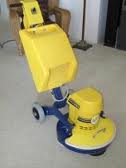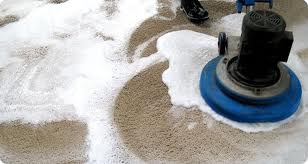Differences in Carpet Cleaning Methods
One the biggest areas of confusion for homeowners looking for a quality carpet cleaning company is deciding which cleaning method to use. The answer to this question will be determined by which aspects of each method are most important to you.
This report outlines some of the basic differences between the most popular cleaning methods available as well as their individual strengths and weaknesses, so that you can make an informed, intelligent decision, rather than crossing your fingers and hoping for the best! Remember that each method must in some way employ both “soil suspension” and “soil extraction”. In other words, getting the soil to release from the carpets, and then employing some method of extracting the soil from the carpetand depositing it into a waste tank.
There are four basic methods commonly used today. While they are known by various names, they are commonly called “bonnet cleaning”, “absorbent compound cleaning”, “encapsulation cleaning”, and “hot water extraction (or steam) cleaning”. A fifth method known as “shampooing” is basically defunct and extinct today. (Thankfully!) These five methods can be divided into two basic categories consisting of “dry cleaning” (bonnet, encapsulation, and absorbent compound cleaning) and “wet cleaning” (hot water extraction and shampooing).
The dry method is not actually “dry” in the sense that it is solvent cleaned instead of water cleaned. (as with dry cleaning clothes) Rather, these methods are technically Very Low Moisture (VLM) and are called “dry” because of the small amount of water they use. Typically, these VLM methods are useful for interim or maintenance cleaning only, as they are limited in removed deep or heavy soiling.
Dry Methods
1. Bonnet Cleaning
In this cleaning method, a cleaning solution is sprayed onto the surface of the carpet to break down the soils. A rotary machine with a removable absorbent pad or bonnet on the bottom is then guided over the surface of the carpet.
The spinning action of the pad agitates the cleaning solution and absorbs it into the cotton or microfiber pad. When the pad is soiled, it is exchanged for a fresh one, and so on until the entire carpet has been cleaned. This is the carpet cleaning equivalent to taking a sponge bath.
Pros: Very little water used; dries quickly, relatively inexpensive
Cons: limited cleaning ability, can be hard on carpets, limited extraction capability
2. Absorbent Compound Cleaning
In the absorbent compound cleaning method, a highly absorbent product dampened with cleaning solvents and water (often resembling wet sawdust) is spread over the carpet. A special machine is then used to buff and agitate the compound into the carpet fibers. The soil is absorbed into the compound and the compound is then extracted using a dry vacuum.
Pros: dries almost immediately; relatively inexpensive
Cons: limited cleaning ability; poor vacuuming can leave “sawdust” flakes behind in your carpet.
3. Encapsulation Cleaning
This is a relatively new, innovative method best suited to interim cleaning on low pile, commercial grade carpet. This technology uses a special polymer or crystal that literally encapsulates soil particles on contact. A solution is misted onto the carpet, and a special machine is used to agitate the solution into the fibers. As the solution dries, it forms a crystal that encapsulates the soil particles, which are then removed through routine vacuuming. This product can continue to work for several vacuumings, thus encapsulating and removing even soil that has been introduced to the carpet weeks after the initial cleaning. This is why it works well for commercial applications where a regular, thorough vacuuming is done.
crystal that encapsulates the soil particles, which are then removed through routine vacuuming. This product can continue to work for several vacuumings, thus encapsulating and removing even soil that has been introduced to the carpet weeks after the initial cleaning. This is why it works well for commercial applications where a regular, thorough vacuuming is done.
Pros: fast drying times, low down time and is relatively economical
Cons: limited cleaning ability in heavily soiled conditions, not recommended for
plush residential carpets.
Wet Methods
4. Wet Shampoo
This was the method commonly employed prior to the 1970s but is rarely employed today. With this method, a high foaming solution was applied to the carpet and worked into the fibers, similar to shampooing ones hair. This solution was then extracted with a wet vac. The problem was that while a heavy lather was worked into the carpet, no rinsing step was provided. This left a heavy residue behind in the carpet. Since the detergents were formulated (often) with coconut oil soaps, they often left a sticky residue behind which contributed to the re-soiling of the carpet. This gave rise to the myth that cleaning your carpets will cause them to re-soil quicker. With today’s synthetic detergents as a base, this problem has pretty much gone away.
the carpet. This gave rise to the myth that cleaning your carpets will cause them to re-soil quicker. With today’s synthetic detergents as a base, this problem has pretty much gone away.
Pros: no practical advantages over today’s methods
Cons: long drying times, sticky residues, limited cleaning ability.
5. Hot Water Extraction Cleaning
Hot water extraction cleaning is by far the most effective and widely recommended method in the industry. With HWE, a thorough pre-vacuuming removes all the dry particulate soils from the carpet. A cleaning solution is then sprayed onto the carpet to break down the oils and greases. In some cases, the conditioner is agitated with a grooming rake or rotary brush machine to further enhance the cleaning ability. The soil and solution is then thoroughly rinsed from the carpet by combining a pressurized hot water rinse with a powerful wet vacuum. Most professionals use a truck mounted unit, which uses long solution and vacuum hoses to reach the carpet. The dirty water is deposited in a waste tank located on the truck. There are also “portable” extractors as well as residential “steam cleaners”. These operate on the same principles, but with reduced heat, water pressure, vacuum, and inferior cleaning solutions, they are usually not nearly as effective as truck mounts, and usually result in higher dry times. After the carpet has been rinse extracted, it is recommended that a quality carpet protector be re-applied to the carpet to replace the factory protector which most likely has worn off.
Pros: Required by most carpet manufacturer warranties, recommended by the IICRC, highly effective cleaning capability, strong rinsing phase removes imbedded soils as well as any cleaning solution residues for a true “deep clean”, the “tried and true” cleaning method of the industry.
Cons:Requires expensive equipment, longer dry times than most “dry” cleaning methods (2-6 hours)
These are the basis differences in the common cleaning methods. The dry methods may work for interim cleaning, but simply lack the capability to thoroughly remove all the soils, pollutants, chemicals, and contaminants in your carpet. This is why carpet manufacturers require cleaning using the Hot Water Extraction method every 12-18 months. (Read Shaw and Mohawk Warranties)
Beautiful Carpets and Floors uses truck mounted Hot Water Extraction to clean your carpet for maximum soil removal and longer carpet life span. For commercial applications, we also have the ability to utilize encapsulation cleaning to provide a cleaning maintenance program that fits your needs and your budget.
